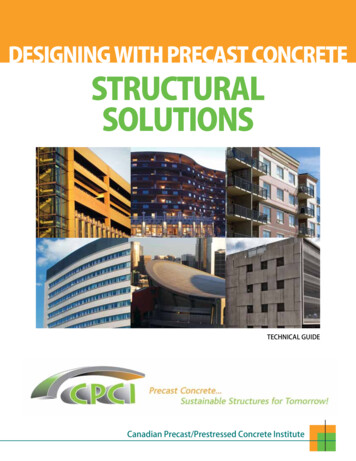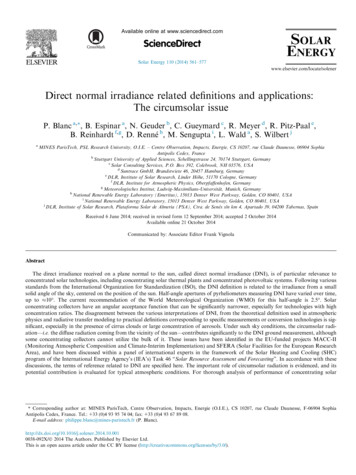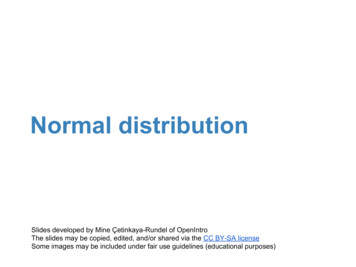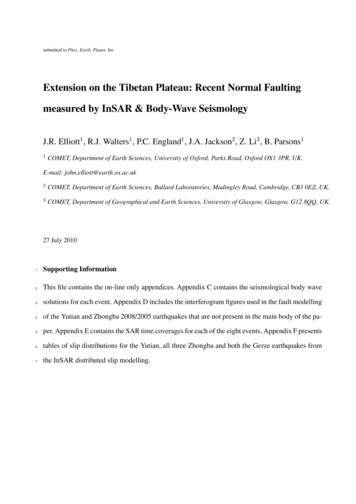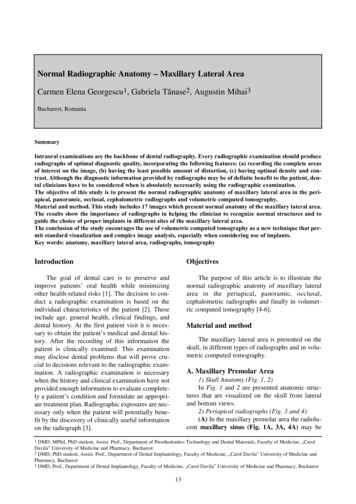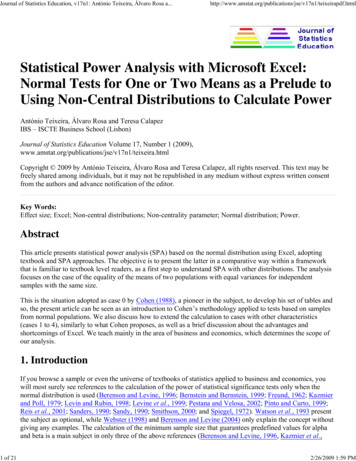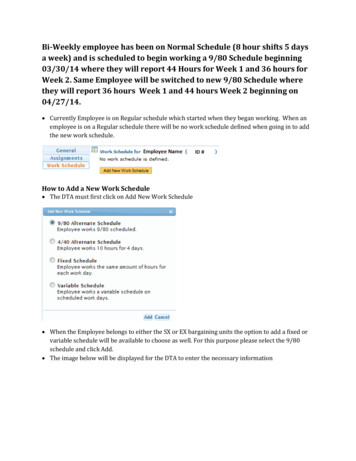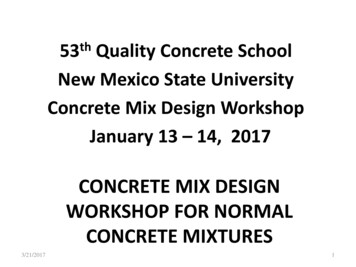
Transcription
53th Quality Concrete SchoolNew Mexico State UniversityConcrete Mix Design WorkshopJanuary 13 – 14, 2017CONCRETE MIX DESIGNWORKSHOP FOR NORMALCONCRETE MIXTURES3/21/20171
Mix Design is the Recipefor the Concrete (Stew) The basic materials are (ingredients).Cement(flour, thickener)Fine aggregate(rice)Coarse Aggregate (vegetables)Water.(water)
Range in Proportions
Cement “What Does it Do?” Cement sets and hardens by reactingchemically with water. The reaction is called Hydration. Forms a stone like mass called PASTE
Cement ASTM C150 or C1157for most Concrete Const.I- For General ConstructionII-Moderate protection against Sulfate attackIII-Used to achieve faster setting Early Strength Gain.V- For severe exposure to Sulfate, ifanticipated
Cement One cubic foot of Cement is 94 lbsOne bag of Cement is 94 lbs4 bags 1 Barrel of cement200 Barrel silo x 4 800 sack x 100# 80,000# / 2000 #/ton 40 ton silo / 25ton loads 1.6 loads of cement Specific Gravity is 3.15
New Type of Cement ASTMC1157 Blended cement used in ResidentialConstruction Combination of cement andsupplementary cement materials. Called a “Green” cement
Supplementary CementitiousMaterials Fly Ash Class CFly Ash Class FNatural Pozzolans Class NGGBFC - a ground granulate blast furnace slag- Grade 80,100 & 120 Calcined Clay or Metakaolin Silica Fume
Supplementary CementitiousMaterialsFrom left to right:Fly ash (Class C)Metakaolin(calcined clay)Silica fumeFly ash (Class F)SlagCalcined shale
Class C Ash adds strength to theconcrete by reducing the amountof cement when added to the mixdesign. Class C Ash does not offsetthe ASR requirement.In the West we have class F fly ashfrom the power plants.
Fly Ash
Mix Design Cement is replaced with a % of Fly AshExampleCement -- 500 lbs 81 %Fly ash -- 120 lbs 19 % of the totalTotal -- 620 lbs / 94 lb/bag 6.6 bags
Coarse, Intermediate and FineAggregate3/21/201714
3/21/201715
AggregatesFine and CoarseCoarse aggregate is 1” to No. 4This means the coarse aggregate passes the1” screen opening and screened over a #4 or¼” opening.Fine aggregate is No. 4 to pan3/21/201716
Testing Coarse Aggregate SieveShaker w/7 Screens3/21/201717
Coarse Aggregate Sieve3/21/201718
Aggregate size 1.5” means the square opening of thescreen is 1.5”. 1.0” is a opening of 1” ¾” is a opening of ¾” ½” is a opening of ½’ 3/8” is a opening of 3/8” #4 screen has 4 openings per inch.3/21/201719
Fine Aggregate Sizes # 8 there are 8 openings per inch each way#16 there are 16 openings per inch#30 there are 30 openings per inch#50 there are 50 openings per inch#100 there are 100 openings per inch#200 there are 200 openings per inch3/21/201720
A nest of sieves #4 to # 200Fine Aggregate 1
Fine Aggregate at SSD Breaks offafter being compacted by the tamperASTM C128-07a 25 dropsabout 5mm ¼” 6.35 mm3/21/201722
Fine agg. Mold and TamperMeasures the SSD conditionASTM C128-07a 25 drops about 5mm ¼” 6.35 mm3/21/201723
Coarse Aggregate SSD & DrySSD Aggregate3/21/2017Dry Aggregate24
Total Moisture Contentof material Wet weight2106.8 gm2496.0 gmDry weight - 2031.0 gm- 2371.0 gmWt of water75.8 gm125.0 gmwater75.8/2031.0 3.7 125/2371 5.3SSD % example -2.7SSD - 1.5Excess water 1.0 % 3.8 %3/21/201725
Potable Water Recommended
Water Should be potable– Has no pronounced taste or odor. Canbe used as mixing water for concrete.– Some recycled water is being used inthe market, but producers are checkingthis so it does not have adverseproblems on the concrete.– We have to recycle.– ASTM C 1602 regulates mixing water.
Water Quality of concrete is influenced by theamount of water used with the amount ofcement. Higher water content dilutes the cementpaste (the glue of concrete).
Why Reduce the Water Content? Increased compressive strength Increased resistance to weathering Lower permeability increases watertightness and lower absorption.
Water Cement Ratio
3/21/2017Water-cement ratio experiment31
Air voids left by evaporation of excess waterare responsible for varying densities.3/21/201732
Why Reduce the WaterContent? Better bond between concrete andreinforcement Reduces volume change from wetting anddrying Reduced shrinkage and cracking
Chemical AdmixturesDEFINITIONIngredients in concrete other than Portlandcement , water, and aggregates- Are added tothe mixture immediately before and duringmixing.
Chemical Admixtures Air-entrained agentsNormal water reducersRetarding water reducersMidrange water reducersHigh range water reducing admixtures (supersplasticizers) Viscosity modifying admixtures Accelerating water reducers Accelerators
Admixture Colors
Chemical Admixtures AIR ENTRAINING ADMIXTURE (AEA)Stabilize microscopic bubbles in concretewhich can provide freeze thaw resistant andimprove resistance to de-icer salt scaling. Donot trowel finish with entrained air over 3%.
Entrained Air in Concrete
Chemical AdmixturesHIGH RANGE WATER REDUCING ADMIXTURES(Super Plasticizers)Reduces the water content by 12% to 30% whilemaintaining slump.Produces flowing concrete without the additionof water.
Chemical AdmixturesHIGH RANGE WATER REDUCING ADMIXTURESExample:36 gal / yd x 8.33 lb/gal 300 lb/yd36 gal x 12% 4.3 gal x 8.33 36 lbs36 gal x 30% 10.8 gal x 8.33 90 lbsThis is ASTM Type F (Normal Set)and Type G (Retarding Set).
High range water reducingadmixtures added at the site
High range water reducingadmixtures added at the site Generally there is a 3- to 4-inch slumpconcrete at the job site. Add 3 gallonsof Super Plasticizer to the mix and youwill get 7- to 8-in slump concretewithout any water added. One hourlater the concrete reverts to the original3- to 4- inch slump.
High range water reducingadmixtures added at the siteHigh range increases the slump from a4” to a 8” with 3 gallons in a 10 cuydload. Normally it would have taken 4gals of water per yard to increase theslump 4” or 40 gallons of water toincrease the slump in a 10yd load36 gal x 12% 4.3 gal x 8.33 36 lbs
Slump Test3/21/201744
High Range Water Reducerno Water added
Flow able Concrete3/21/201746
3/21/201747
3/21/201748
Factors in the Proportioning ofQuality Concrete nomy3/21/201749
Strength and Durability3/21/201750
Mix CharacteristicsStrengthWater-cementing materials ratioAggregate size and volumeAir contentSlump and workabilityWater contentCementing materials content andtype Admixtures3/21/201751
Determination of Cement ContentCement Content ExampleRequired Water Contentair-entrained concrete1-in. max. size aggregate3-in. slump295 lb/yd3 Water0.53 W/C-ratio3/21/2017Water-Cement Ratio 557 lb. cement peryd3 of concrete52
Methods for ProportioningConcrete Mixtures Water-cement ratio method Weight method Absolute volume method Field experience (statistical data) Trial mixtures3/21/201753
Design an Air Entrained Concrete Mixby Absolute Volume Computations Use Designing and Proportioning Normal ConcreteMixtures. PCA 16th edition EB0012.14 (Hand Out) PCA 16th edition chapter 15 Material PropertiesWater: Unit Weight 62.4 pcf: 8.33 lb/galCement: Specific Gravity 3.15: 94 lb /sk or cuftCoarse Agg. Oven dry 0% , SG 2.62 Max. size 1”Dry-rodded Unit Wt. 96 pcf Abs.0.5%Total Moist. Cont of CA 1.5%3/21/201754
Mix Design for 2017The mix design will require f’c 4000 psi with entrained aira F1 exposure per table 15-15-1 and a S1 Exposure classper 15-2. No test data .31.4.41.4.5Water specific gravityCement brand for exampleType of cementCement specific gravityOther material (fly ash type F)Coarse AggregateSpecific Gravity Oven Dry (OD)Nominal Maximum sizeDry rodded unit weightAbsorption of the rockTotal moisture of the Coarse aggregat1.00GCCI-II, LA3.152.102.621.0 inch96 pcf0.5 %1.5%
4Fine AggregateSpecific Gravity oven Dry (OD)Fineness Modulus (FM)Dry rodded unit weightAbsorption of the fine aggregateMoisture of the fine aggregateAdmixture’sTypeDosage per 100 weight (cwt)TypeDosage per 100 weigh of cement (cwt)2.602.60100 pcf1.0%5.0%entrainedoz/cwtWater red.oz./cwt
Concrete Mix Design & ProportioningPortland Cement Association16th Edition EnglishPCA Method by absolute volumeSimilar to example2 on page 3731.- (Materials)1.1.- (Water)W1.1.1.- (Specific Gravity)unit wt. of water 62.4 pcf water weighs 8.33 lb/gal @ 60F1.2. – (Cement) C1.2.1.- (Brand of Cement)1.2.2.- (Standard, Type)1.2.3.- (Specific Gravity)1.3 – (Other Materials)1.3.1. – (Fly ash) Class F1.3.2. – (Silica fume)1.3.3. – (Slag gbfs)
1.4.- (Coarse Aggregate) ASTM C-331.4.1.- (Specific gravity oven dry (OD)1.4.2.- (Nominal Maximum size agg1.4.3.- (Bulk Density(OD) (unit wt.)1.4.4.- (Absorption) %1.4.3.- (Moisture) %pcf%%1.5. – (Fine Aggregates) ASTM C-331.5.1- (Specific Gravity (OD))1.5.2.- (Fineness Modulus FM)1.5.3.- (Bulk Density OD)(unit wt)pcf1.5.4. – (Absorption) %%1.5.5. – (Moisture) %%
1.6--- Admixture1.6.1 – (Type)1.6.2. – (Dosages)oz /cwt1.6.3 – (Type)1.6.4 – (Dosages)oz/cwt
2. - (Design Specifications)2.1. – (Specified Strength) f’cpsi2.1.a required avg strength f’cr over design psiThis is from table 15-102.1.b sum 2.1 2.1.b f’crpsi2.2. – (Age)daysgenerally 28 days2.3. – (Exposure conditions) table 15-12.3a- (Exposure conditions table 15-2)2.3b –w/c from table 15-3 interpolated(Weight calculations) Mixing water/Water-cement ratio(choose the lowest w/c)2.4. – (Air content) table 15-5(Class F1) 1”agg%2.5. – (Slump) from table 15-5inches2.6. – (Nominal Maximum Size)2.7. – (Other)
3. – (Data from tables or figures)(hand out)16th edition3.1. – Water Cement Ratio) W/CUse the lowest w/c of 2.3, 2.3a, & 2.3b above3.1.1. – lowest water /cement ratio3.2. – (Entrapped air) (Table) 15-53.3. – (Air Content)(Table) 15-53.4. – (Mixing water) (Table) 15-53.5. – (Coarse aggregate bulk volume) (table) 15-4) nominal maximumsize aggregate and the FM of the fine aggregate
Requirements for Exposure ConditionsExposure conditionTable 15-1Maximum w/c- Min. strength,ratio by mass f'c, MPa (psi)No freeze-thaw, deicers,aggressive substancesSelect for strength,workability, andfinishing needsSelect forstructuralrequirementsConcrete with low permeability; exposed to water0.5028 (4000)Concrete exposed tofreezing and thawing in amoist condition or deicersF2, S2 ----0.4531 (4500)For corrosion protection forreinforced concreteexposed to chlorides0.4035 (5000)
Table 15-1 see F1 0.553/21/201763
Requirement for Concrete Exposed to Sulfatestable 15-2 S1 in the exampleSulfate(SO4) inSulfatesoil, % byexposure massNegligibleSulfate(SO4) inwater,ppmMinimumMaximum strength,w/c-ratio, f'c,Cement type by massMPa (psi)LessLess than No special—than 0.10 150type required—Moderate0.10 to0.20150 to1500II, 20 to2.001500 to10,000V, HS0.4531 (4500)VerysevereOver2.00Over10,000V, HS0.4035 (5000)0.5028 (4000)
Table 15-2 see S1 0.50
Relationship between W/CRatio and Strength table 15-3Water-cementitious materials ratioby massCompressivestrength at Non-air-entrained28 days, 0000.820.74Inch-Pound
Water and Air Requirementsfor Different Slumps and Sizesof Aggregate Table 15-5Water, pounds per cubic yard of concrete, forindicated sizes of aggregate3/8in.Slump, in.½ in.¾in.1 in.1½in.2 in. 3 in.6in.1 to 2350 335315 300 275260 220 1903 to 4385 365340 325 300285 245 2106 to 7410 385360 340 315300 270 —Approximate amount ofentrapped air in non-airentrained concrete, percent32.521.5Non-air-entrained concrete10.50.30.2Inch-Pound
Water and Air Requirements for DifferentSlumps and Sizes of Aggregate Table 15-5Water, kilograms per cubic meter of concrete,for indicated sizes of aggregate3/8in.Slump, in.½ in.¾in.1 in.1½in.2 in. 3 in.6in.1 to 2305 295280 270 250240 205 1803 to 4340 325305 295 275265 225 2006 to 7365 345325 310 290280 260 —Recommended average total air content,percent, for level of exposureMild exposure4.54.03.53.02.52.01.51.0Moderate exposure6.05.55.04.54.54.03.53.0Severe exposure7.57.06.06.05.55.04.54.0Air-entrained concreteInch-Pound
Bulk Volume of Coarse AggregateMaximum sizeof aggregate,mm(in.)Fineness modulus of 10.690.670.6537.55075150(1 .740.780.830.690.720.760.81
4. – (Weight calculations) Mixing water/Water-cement ratio(choose the lowest w/c)You can change the amount of cement if the concrete is Used forflatwork or a sever exposure. See Tables 15-1, 15-2 or 15-6 .Mightbe a combination of several cementitious materials4.1. – (Cement) (3.4)/(3.1) lbs/ydlbs water / 0. lb of cement lbs / cu.ydBags of cement (4.1) / 94 lb/sacksacks/ 94 sacks of cement4.2. – (Coarse aggregate)Bulk Density OD X Coarse aggregate volume(1.4.3) x (3.5) coarse agg. In lb./cy.lb/cuydpcf x cuft x 27 cu ft lb / cuyd
5. – (Absolute Volume Calculations)5.1. – Water W (3.4)( )/1.0x62.4 cuft5.2. – Cement C (4.1)/(1.2.2)( ) / 3.15 x 62.4 cuft5.3. – Coarse Aggregate G (4.2)/(1.3.1)( ) / 2.62 x 62.4 cuft5.4. – Air (Select) (3.2) or (3.3)( ) x 27 cuft / cuyd5.5. – (Sub-total)cuftcuft5.6. – Fine Aggregate S (Volume Unit – 5.5)27 cuft – 5.527 – cu ft of fine aggregatecuft5.7. – Fine aggregate weight S (5.6)x1.4.1)( ) x 2.60 x 62.4 lb/cu
6. – Density (unit Weight)6.1. – Cement C6.2. – WaterW6.3. – Coarse Aggregate G 0% moisture6.4. – Fine Aggregate S 0% moistur
Cement ASTM C150 or C1157 for most Concrete Const. I- For General Construction II-Moderate protection against Sulfate attack III-Used to achieve faster setting - Early Strength Gain. V- For severe exposure to Sulfate, if anticipated
